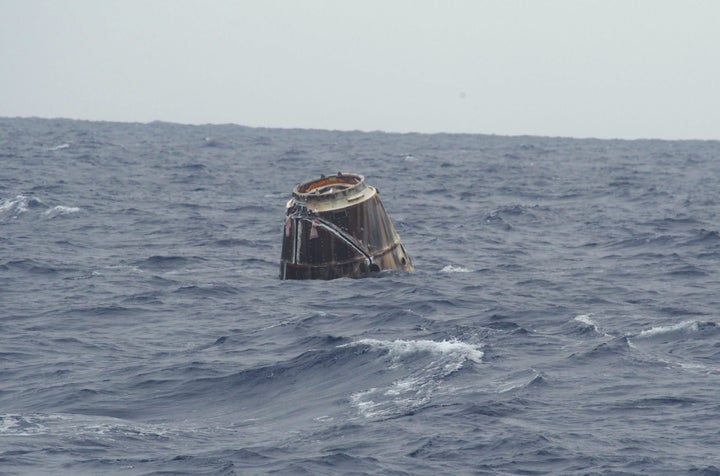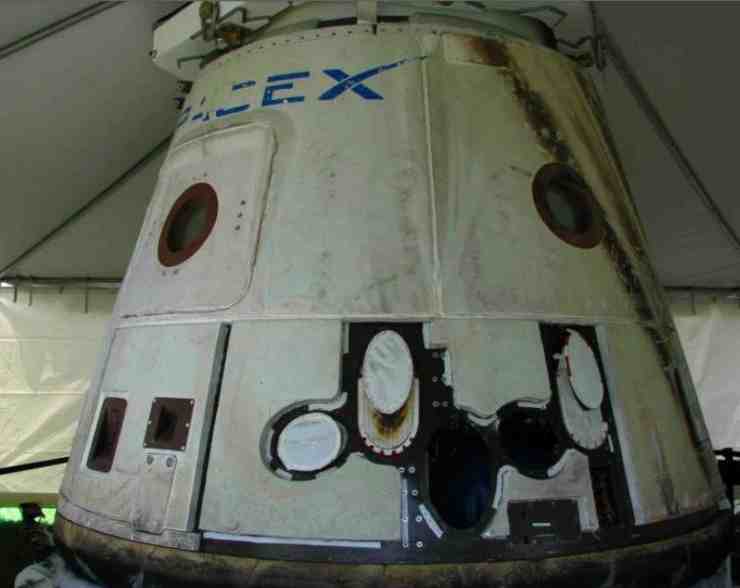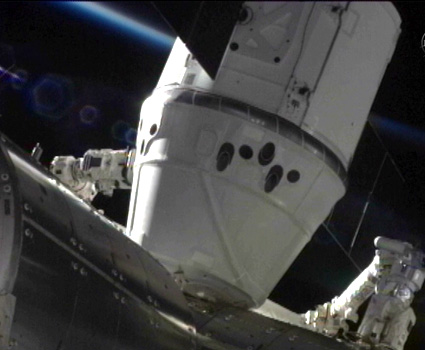
co-authored with Douglas Dechow
On Tuesday, May 22, we wrote about the successful launch of SpaceX's Dragon capsule. Since then, Dragon synced up its orbit with the International Space Station and, on May 25, berthed.
This low-Earth-orbit hook-up isn't technically docking. The space shuttle docked by moving closer and closer to the space station, astronauts piloting the orbiter to the right spot and latching on. Instead of Dragon maneuvering its own way toward the Harmony module, the International Space Station's 60-foot robotic arm reached out and grabbed it on that Friday morning. Dragon is no shuttle, with all the good and not-so-good that implies.
Unlike the shuttle, which landed like an airplane, Dragon splashes down in the ocean like Apollo. That's just what it did on the morning on May 31, pretty much where SpaceX said it would and less than a year after the shuttle's penultimate mission.
 We knew all these things about how Dragon is supposed to work already. The day after we watched Atlantis lift off at Kennedy Space Center for the last-ever shuttle mission last July (see that launch video and launch photos at Lofty Ambitions blog), we visited SpaceX Launch Control Center, which shares its parking lot with the Air Force Space and Missile Museum. On the grounds that day, under a tent, was the Dragon spacecraft that had orbited the Earth in late 2010 and returned, not too much worse for wear, though certainly scorched by re-entry. We wondered then, with space shuttle Atlantis orbiting overhead, whether Dragon was really going to be the next stage of U.S. manned spaceflight, whether SpaceX could manage the task and, if so, how quickly.
We knew all these things about how Dragon is supposed to work already. The day after we watched Atlantis lift off at Kennedy Space Center for the last-ever shuttle mission last July (see that launch video and launch photos at Lofty Ambitions blog), we visited SpaceX Launch Control Center, which shares its parking lot with the Air Force Space and Missile Museum. On the grounds that day, under a tent, was the Dragon spacecraft that had orbited the Earth in late 2010 and returned, not too much worse for wear, though certainly scorched by re-entry. We wondered then, with space shuttle Atlantis orbiting overhead, whether Dragon was really going to be the next stage of U.S. manned spaceflight, whether SpaceX could manage the task and, if so, how quickly.
Of course, less than a year after the shuttle's last mission, on May 26 (at 2:53a.m. here in California), residents of the space station opened the hatch of Dragon, one step in a really successful mission, the first of its kind by a private company. The six crew members of Expedition 31 -- three Russians, two Americans, and a Dane -- subsequently unloaded a thousand pounds of cargo, including science experiments developed by students. One experiment (from California, of course) aims to determine whether wine ferments faster in microgravity, in hopes of discovering that fermented foods can be produced more quickly. Another experiment studies the effects of microgravity on treatments for bone loss. The International Space Station is, after all, a global science laboratory, and SpaceX understands the need to get the next generations interested in space exploration as well as what are referred to as the STEM disciplines: science, technology, engineering, and math. So Dragon and SpaceX continue the work of the shuttle and NASA.
What was really important about this mission, though, is that the crew filled Dragon with cargo to come back to Earth. None of the other re-supply vehicles can take cargo from the space station and return it safely to the ground. All but Soyuz burn up on re-entry, and as Elon Musk, head of SpaceX, reiterated in a news briefing while Dragon was still in space, Soyuz is designed to transport people, with cargo capacity roughly the size of a knapsack. In fact, when asked about Dragon's carrying capacity, Musk said that, if it needs to be bigger, they'll make it bigger. In this way, Dragon is like the shuttle, and that's why it's necessary for this present moment.
 So, what's next? For Dragon, another demonstration mission late this year. For SpaceX, there's buzz about an IPO, though Musk tried to quell anticipation, saying that he'd feel comfortable with that only when they are able to "launch every month" and, therefore, "had good predictability about the future." And Sierra Nevada is working on Dream Chaser, a spaceplane akin to the shuttle but with a design based on the HL-20 lifting body, to rival SpaceX's Dragon, though test flights aren't scheduled until 2016.
So, what's next? For Dragon, another demonstration mission late this year. For SpaceX, there's buzz about an IPO, though Musk tried to quell anticipation, saying that he'd feel comfortable with that only when they are able to "launch every month" and, therefore, "had good predictability about the future." And Sierra Nevada is working on Dream Chaser, a spaceplane akin to the shuttle but with a design based on the HL-20 lifting body, to rival SpaceX's Dragon, though test flights aren't scheduled until 2016.
The United States plans to use the International Space Station through 2020, perhaps as long as 2028. That's between eight and sixteen more years. Then what? We ask because the first component of the space station was launched in 1998, and people moved in on November 1, 2000. That's twelve years to build it, not including development that occurred earlier. If we want a manned space program to follow this low-Earth-orbit science project and international achievement, we must plan now.
Friday, May 25, Dragon's berth-day, marked the anniversary of President Kennedy's speech to Congress in 1961, urging support for, among other things, the idea that "that this nation should commit itself to achieving the goal, before this decade is out, of landing a man on the moon and returning him safely to the earth." Eight years later, Neil Armstrong stepped onto the Moon. But we no longer face the same "adversaries of freedom." The International Space Station represents global cooperation, not a Space Race we must win. Still, Kennedy's rule of thumb for making such big decisions holds:
[T]here is no sense in agreeing or desiring that the United States take an affirmative position in outer space, unless we are prepared to do the work and bear the burdens to make it successful. If we are not, we should decide today and this year.
Is NASA's Orion capsule atop a Delta IV Heavy rocket the next big step? Will SpaceX's Falcon Heavy rocket, reportedly with twice the carrying capacity of the Delta IV Heavy, eclipse NASA's plans? Should we reach toward an asteroid, the Langrange points, or Mars? No matter what the nation decides regarding the future of manned spaceflight, the success of Dragon these past couple of weeks have established that SpaceX will have a role to play in that future.
